Hyundai Elantra (CN7): Parking Brake System / Electronic Parking Brake (EPB)
Description and operation
The electronic parking brake (EPB) is different from existing parking systems which operated with the brake pedal or the lever type. The EPB system sends the signal to the ECU when a driver operates the EPB switch. The ECU operates the EPB actuator composed with motor gears. The braking power is caused by occurs when the motor pulls the cable connected the brake system.
The EPB ECU is one of the parts of EPB system. It perceives the signal of the various sensor of system, executes a self diagnosis, controls EPB system with the logic.
Main Function
| 1. | Static Braking Mode The operation and the cancellation at the stop condition of the vehicle | (1) | The operation condition: Pull the EPB switch irrespective of the brake pedal pressed condition. (Pull). | –
| The Vehicle speed <= 3kph |
|
| (2) | The cancellation condition: Push the EPB switch at the ignition switch on & the brake pedal pressed condition. (Push). |
|
| 2. | Dynamic Braking Function Dynamic Braking Function (DBF) : The DBF is the braking function at the driving condition, it can operate the EPB system and cancel it at the vehicle driving condition. This function will be used while foreign materials get in between the brake pedal or the brake hydraulic line can not be operated. | (1) | The operation condition It operated only when the vehicle speed is faster than 3kph and the EPB switch is pushed. |
| (2) | The cancellation condition: It canceled when the pulling of the EPB switch is stopped. |
| (3) | Principle of Operation | –
| ESP system is normal condition: EPB requests applying pressure of brake to ESP system. |
| –
| ESP system is abnormal condition: EPB operates the parking brake for reduction of speed. |
|
| (4) | Peculiarity Anti-lock is operated when occurring wheel lock. Parking lamp on the cluster illuminates in the case of emergency braking. |
|
| 3. | Drive Away Release Convenient for drivers, EPB is automatically released when driver shift from P into another (R/N/D/S) during braking. |
| 4. | Latching Run This is reconnection function to operate EPB normally after emergency release. Operation | (1) | After emergency release, when operating EPB first, the hook connects to the claw in the EPB with operating parking brake with maximum cable tension. |
| (2) | Reconnection function can be performed with the GDS. |
| (3) | After testing for reconnection 5 times, EPB isn’t be operated in the present ignition switch cycle when EPB doesn’t reconnect normally. |
|
| 5. | Bedding Mode You must do "Bedding in process" for optimizing the initial operation performance of EPB after replacing the parking brake shoe and rear brake disc. Bedding in Process | (1) | Ignition on, start engine. |
| (2) | Apply the foot brake 2 times within 10 seconds and hold applied after the last application. |
| (3) | Apply the EPB switch 4 times, followed by 3 release applications within 10 seconds. |
| (4) | The linings must be bedded-in by 6 repeated dynamic braking procedures from 30-35 km/h to vehicle standstill. (If the vehicle speed is over 50 km/h at the Bedding Mode, it is automatically released.) |
| (5) | After each braking cycle a cooling period for the linings is necessary to prevent lining damage. | –
| The cooling can either be carried out via driving a 500 m distance after each braking cycle without any apply of the EPB or via keeping the vehicle in standstill for 1 minute after each braking. |
|
|
| 6. | AVH (Automatic Vehicle Hold) AVH supports to keep a stop condition of the vehicle by hydraulic brake at a stop. | (1) | Condition for operation | –
| Fastening driver seat belt |
| –
| A gear shift is not P-range |
| –
| Perfect stop condition with hitting the brake pedal. |
|
| (2) | AVH function holds stop condition of the vehicle for maximum 5 minutes. VDC valve keeps stop condition because of intercept the oil passage with pressure occurred from brake pedal. |
| (3) | An accumulated time of AVH operation : Max. 30min |
| (4) | Automatic release function AVH mode is released when driver attempts starting a vehicle by pedaling an acceleration pedal at the D/ S/ R range. |
| (5) | Automatically convert AVH to EPB AVH will convert EPB operation automatically if any one satisfy conditions below. [Normal conversion case] | –
| In the case of driver door open & Driver seat belt release at the same time |
| –
| In the case of opening the hood while the shift lever is D or S. |
| –
| In the case of opening the trunk while the shift lever is R |
| –
| In the case of over 5 minutes of AVH operation time |
| –
| Stop at a slope of twenty five degrees |
[Abnormal conversion case] | –
| When sensing detailed motion of the vehicle. |
| –
| When sensing the fault of ESP hydraulic system. |
|
|
Warning Lamp
| 1. | EPB warning lamp EPB warning lamp indicates the EPB cut and malfunction. EPB warning lamp comes ON below cases. | (1) | EPB warning lamp comes on for 3 seconds after the ignition switch is ON. If EPB system is working properly, EPB warning lamp goes OFF |
| (2) | If EPB system is not working properly, EPB warning lamp comes ON |
| (3) | Under diagnosis mode, EPB warning lamp comes ON |
|
| 2. | AUTO HOLD lamp / AUTO HOLD function lamp | (1) | AUTO HOLD switch ON | A. | Brake system operates automatically when vehicle speed is "0", in the case of parking or waiting at a red light, during braking (AUTO HOLD function lamp : Green) |
| B. | Brake system is released automatically when step on the accelerator pedal. (AITO HOLD lamp : White) |
|
| (2) | AUTO HOLD switch OFF : AUTO HOLD function does not operate. |
|
Components and components location
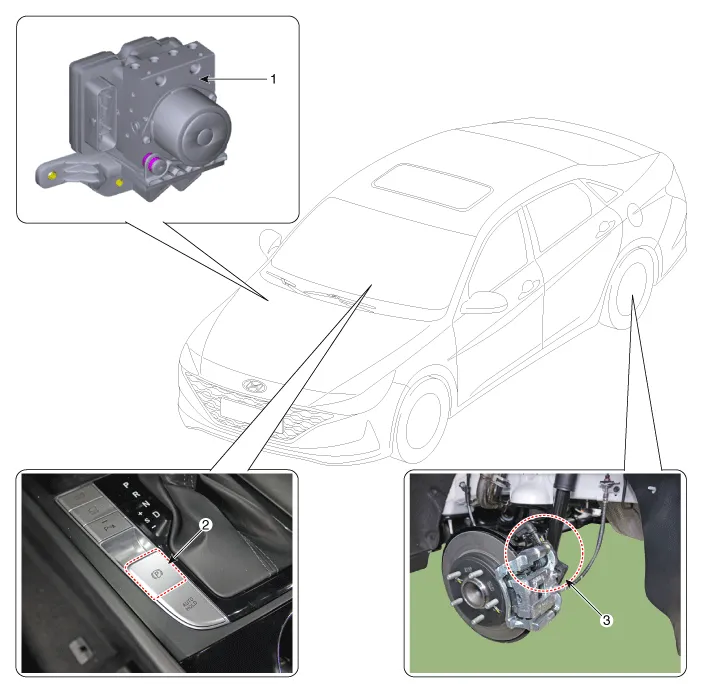
1. ESC Control Module
2. EPB switch
| 3. Electronic Parking Brake (EPB) actuator
|
Schematic diagrams
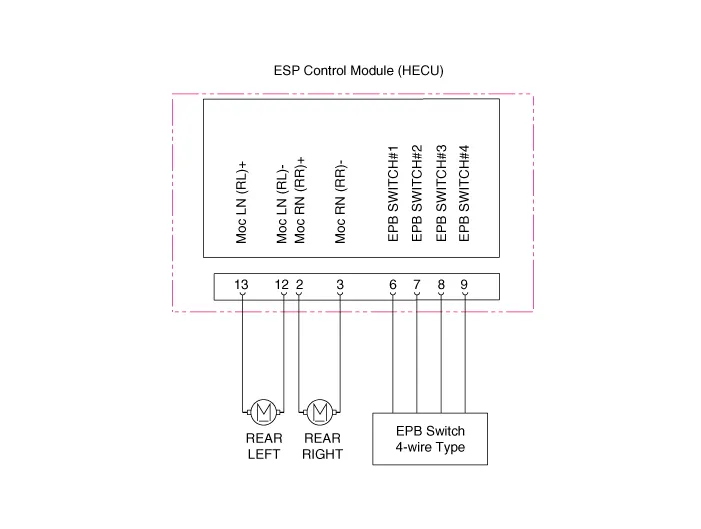
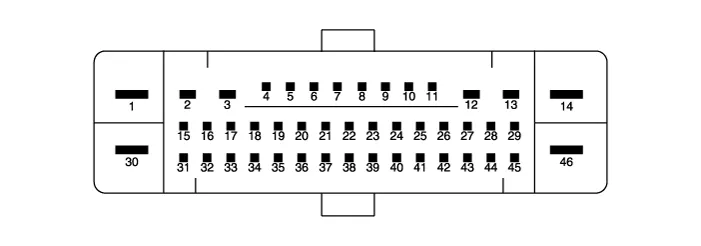
Pin No
|
Fuction
|
Pin No
|
Fuction
|
6
| Electrical parking brake signal 1
| 2
| Rear right EPB motor power
|
7
| Electrical parking brake signal 2
| 3
| Rear right EPB motor ground
|
8
| Electrical parking brake signal 3
| 12
| Rear left EPB motor ground
|
9
| Electrical parking brake signal 4
| 13
| Rear left EPB motor power
|
Repair procedures
| 1. | Turn ignition switch OFF and disconnect the negative (-) battery cable. |
| 2. | Remove the console upper cover. (Refer to Body (Interior and Exterior) - "Floor Console") |
| 3. | Disconnet the EPB switch connetor (A). 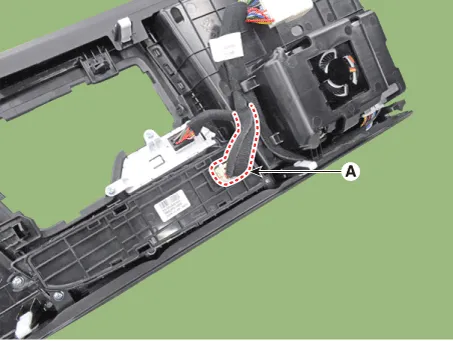
|
| 4. | Remove the EPB switch (A) after loosening screw. 
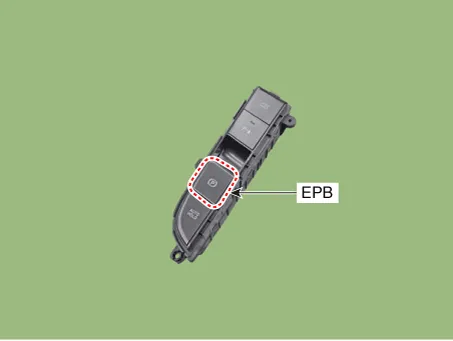
|
[EPB Actuator]
| 1. | Turn ignition switch off and disconnect the battery (-) cable from the battery. |
| 2. | Remove the rear wheel and tire. |
| 3. | Remove the EPB actuator from rear caliper. (Refer to Brake System - "Rear Disc Brake") |
Repair procedures
Removal1.Turn ignition switch OFF and disconnect the negative (-) battery cable.2.Release the parking brake.3.Remove the floor console assembly.
Other information:
Replacement1.Disconnect the negative (-) battery terminal.2.Remove the crash pad lower panel.(Refer to Body - "Crash Pad")3.Remove the steering column upper & Lower shroud.4.Remove the ignition switch and disconnecting the Key Warning / immobilizer connector.
Description•
PDW consists of 8 sensors (front : 4 units, rear : 4 units) that are used to detect obstacles and transmit the result in three separate warning levels, the first, second and third to IBU via LIN communication.•
IBU decides the alarm level by the transmitted communication message from the slav






